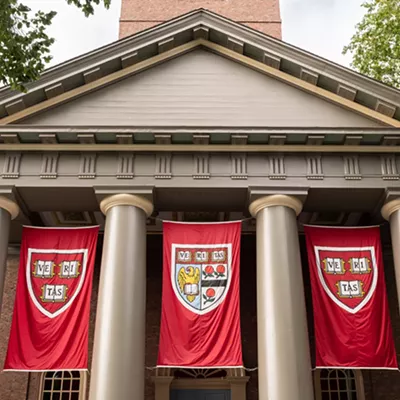Then throw him into Silicon Valley and let him rub elbows with soon-to-be millionaires in the computer industry. He then works on books dealing with the history, sociology and use of computers. And he continues to work on software design, training programs and commercial hypertext products.
He picks up the inside scoop of the Silicon Valley entrepreneurs and then co-founds a company that makes "quake kits" and a small press whose title, It's Okay to be Happy, hit the California-dreaming generation right between the eyes.
Chris Kelly saw all those success stories in Silicon Valley and felt a pang years later for a return to his Spokane roots to try his hand at growing startups here. Sure, bringing Silicon Valley to Spokane sounds like a punchline to a bad joke, but Kelly has persisted, and now he's the pitchman for a project that just might be the catalyst to pump up Spokane's volume: the Phoenix Project.
"Spokane doesn't have a dense network of relationships yet," says Kelly, "but if you put all the elements necessary for a startup to thrive in one place, along with a bunch of creative people, fun things to do, places to go, you'll have established critical mass. The explosion of creativity will spread throughout the region, bringing new businesses and new jobs to nearby cities like Richland and Sandpoint as well as to Spokane and Coeur d'Alene."
While all the confluence of factors bode well for Kelly's Phoenix Project -- WSU's avowed mission, the U-District's geographic location and growing interest in preserving and retrofitting the 1909 Jensen Byrd building -- Kelly's May 10 open forum may wind up landing his project somewhere else.
"Although ideally suited for the Jensen-Byrd building, and although it would provide a de facto student center for WSU at no cost to them, the Phoenix Project doesn't have to be at the Jensen-Byrd building."
& lt;span class= & quot;dropcap & quot; & P & lt;/span & o Bronson likes Chris Kelly's idea for the Jensen-Byrd building as a space for writers. Bronson founded the San Francisco Writers' Grotto in 1994. Just a few writers coming together in a small space has now increased to 32 authors, journalists, fiction writers, filmmakers, poets, critics and other "narrative artists."
Bronson knows Spokane, knows Kelly and has put his blessing on a Spokane Writers' Grotto incarnation as envisioned in Kelly's Phoenix Project at the Jensen-Byrd building.
The idea is to offer small office space for a low monthly price. Get writers to conjure up the muses and start the creative juices flowing by having large open areas that might include editing workshops. Or public readings. And classes at night. A small press. Tie it all to creative writing programs, Get Lit! and the area's rich writing culture.
Bronson knows a writer can function in his underwear at home with paper pad and pencil. Or she can be self-contained in a dreary bar with a laptop; however, the sense of having an office to go to and a public arena from which to brainstorm and share -- well, those situations are special and worth the investment.
"The original hypothesis -- that community is conducive to productivity -- has proven abundantly true," says Bronson. "In the past 12 years, a steady stream of books, articles, feature films, television series, short stories, poems and essays have had their genesis here. For Spokane, the idea fits."
& lt;span class= & quot;dropcap & quot; & J & lt;/span & eff Herman sorts apples with his wife as part of his job as a fruit grower in Kettle Falls as part of Cliffside Orchard. He also conjures up big plans for the Spokane Farmers' Market as a guiding force behind the Phoenix Project.
Kelly has met with Herman and other growers and food producers several times to bring his Phoenix Project to the people he believes would be the anchor for the Jensen-Byrd vision. Outside near the large warehouse is plenty of land for an outdoor farmers' market. Herman likes the space but is worried about the timeline and all the hoops Kelly has to jump through to get people convinced the multi-use proposal is attractive enough to buy into.
Herman has some strong feelings about how hard it's been for the farmers to get political forces behind a city market.
"I think the lack of initiative by Spokane's political base comes more from a lack of understanding about the potential and desire for a strong, thriving Spokane Farmers' Market," says Herman. "It surprises me when I talk to people about other cities, with thriving farmers' markets, how often those markets are mentioned. It might not be the first attribute of a city they talk about, but it comes up. I feel that for very little financial investment and public support, the Spokane Farmers' Market could be a great attribute to this city, in the eyes of people who live here and the businesses and people who look to move here."
The orchardist has even deeper complaints about how WSU has flip-flopped in its commitment to his brethren farmers.
"As a land grant college, part of WSU's mission statement is to support Washington farmers. As agriculture has moved towards larger corporate farms, so has WSU's commitments," says Herman. "It is where the money is.
"I would also like to point out that the Spokane Marketplace, which is gone, was thriving 12 years ago on Division and Riverside. When WSU acquired the property, they threw the market off and essentially killed it. The property has sat unused ever since.
"Now there's a movement from small farms towards direct marketing," Herman continues. "WSU Extension has seen it and supported it. Extension agents are seeing a rebirth of the small farms. It is not a huge percentage of agriculture, and I think this hasn't shown up on the radar of the WSU administration yet. There is not a huge investment required to help this movement. Working a market site into the U-District plan is a great example."















